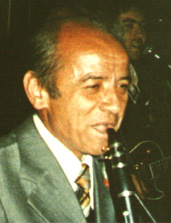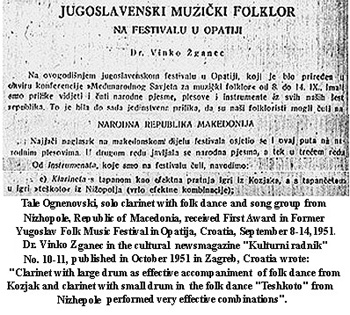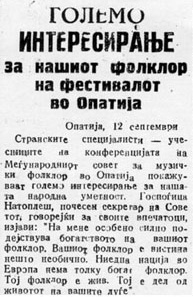 Tale
Ognenovski's First Award at the Yugoslav (Former Yugoslavia) Folk Music
Festival in Opatija, Croatia, 1951.
Tale
Ognenovski's First Award at the Yugoslav (Former Yugoslavia) Folk Music
Festival in Opatija, Croatia, 1951.
85 Folk groups performed at the Yugoslav (Former Yugoslavia) Folk Music
Festival in Opatija, Croatia, that took place during the period September
9 to 13, 1951. They came from Serbia (September 9th, represented by 15
villages), Bosnia and Herzegovina (September 10th, represented by 15 villages),
Montenegro (September 11th, represented by 8 villages), Slovenia (September
11th, represented by 5 villages), Macedonia (September 12th, represented
by 23 villages) and Croatia (September 13th, represented by 19 villages).
"Teshkoto (the virtuoso clarinet soloist was Tale Ognenovski - remark
made by Stevan Ognenovski) from Nizhopole (Bitola) means 'heavy', and indicates
the heavy rhythm which is typical of very ancient dances..." This appeared
in the 'International Folk Music Journal' under the title 'Extracts from
PROGRAMME NOTES ON THE DANCES AND SONGS performed at the Yugoslav Folk
Music Festival', with the subtitle 'MACEDONIA - represented by 23 villages',
published by The International Folk Music Council, London, in March, 1952,
Volume IV, pages 60-64.
At the Yugoslav (Former Yugoslaviia) the Folk Music Festival in Opatija,
the Folk Dance group from the Bitola village of Nizhopole from Cultural
- Educational society "Jonche Georgievski"" from the Bitola village of Dihovo
in which Tale Ognenovski was playing as a clarinet soloist, created a sensation
and received First Award as the best Folk Dance group at the festival.
Tale Ognenovski, with his masterly playing solo clarinet, deserved the
award together with other members of the group. This was a great success
because in this Festival participated 85 different folk dance groups from
Macedonia, Croatia, Serbia, Slovenia, Montenegro and Bosnia and Herzegovina.
The musical part of the group had only two members: Tale Ognenovski played
solo clarinet with the accompaniment of drummer Lambe Petrovski.
This is a musical sensation, to receive the First Award
with an orchestra consisting of only two members. The clarinetist Ognenovski
and drummer Petrovski performed closely together.
The dancers and singers were Vera Cholakovska, Cveta Petrovska,
Sakjime Alimovska, Nada, Marika, Menan, Sefer, Mirko, Vangel, and Dimche
Talevski.
There was a full house at the concert hall in the Kvarner
hotel in Opatija, and the audience was fascinated by the music and the
three dances performed by the Ensemble: 'Za ramo Teshkoto', 'Beranche'
and 'Vlashko za ramo' (these folk dances involved singing by all ten members
of the Ensemble). Tale Ognenovski was arranger of these folk dances, and
made them more effective with his solo improvisations.
3.1. "The clarinet (the virtuoso clarinet soloist
was Tale Ognenovski - remark made by Stevan Ognenovski) was
as effective an accompaniment to the large drum in the folk dance from
Kozjak as it was to the small drum in
the folk dance 'Teshkoto' from Nizhopole. They provided a very effective
combination" - Dr. Vinko Zganec
in 'Kulturni radnik'
In the cultural newsmagazine 'Kulturni radnik' Number
10-11, published in October 1951 in Zagreb, Croatia, Dr Vinko  Zganec
wrote "The clarinet (the virtuoso clarinet soloist was Tale Ognenovski
- remark made by Stevan Ognenovski) was ass effective an accompaniment to
the large drum in the folk dance from Kozjak as it was to the small drum
in the folk dance 'Teshkoto' from Nizhopole. They provided a very effective
combination." This appeared in an article entitled 'Yugoslav Musical folklore
at the Festival in Opatija'.
Zganec
wrote "The clarinet (the virtuoso clarinet soloist was Tale Ognenovski
- remark made by Stevan Ognenovski) was ass effective an accompaniment to
the large drum in the folk dance from Kozjak as it was to the small drum
in the folk dance 'Teshkoto' from Nizhopole. They provided a very effective
combination." This appeared in an article entitled 'Yugoslav Musical folklore
at the Festival in Opatija'.
The audience greets the debut of the group from Nidzopole
with great applause... Delegates at the Conference of the International
Folk Music Council in Opatia from September 8-14, 1951, were present at
this concert. Many of the world's reporters took photos of the members
of the group regarding their excellent debut and their receiving First
Award at this festival (Source: a letter from Mr. Mile Petrovski,
Bitola, Republic of Macedonia, May 15, 1965, and an informal interview
with Mrs. Vera Cholakovska Petrovska and Mr. Mile Petrovski made by Stevan
Ognenovski on May 3, 1998).
3.2. No other nation in Europe has such rich
folklore
 "The
riches of your folklore have a strong influence on me. Your folklore is
something really unusual. No other nation in Europe has such rich folklore."
This comment was by Mrs. Nataplesh, the Honorary Secretary of the International
Folk Music Council (whose headquarters are in London, England), who was
present on the Conference of the International Folk Music Council in Opatia
during the period September 8-14, 1951. (This came from an article entitled
'Great interest for our folklore in Opatija.' It was published in the newspaper
'Nova Makedonija', Skopje, Republic of Macedonia, on September 14, 1951.)
"The
riches of your folklore have a strong influence on me. Your folklore is
something really unusual. No other nation in Europe has such rich folklore."
This comment was by Mrs. Nataplesh, the Honorary Secretary of the International
Folk Music Council (whose headquarters are in London, England), who was
present on the Conference of the International Folk Music Council in Opatia
during the period September 8-14, 1951. (This came from an article entitled
'Great interest for our folklore in Opatija.' It was published in the newspaper
'Nova Makedonija', Skopje, Republic of Macedonia, on September 14, 1951.)
3.3. The Yugoslav (Former Yugoslavian) Folk Music Festival
in Opatija
had been specially arranged for the members of the Conference of
the International Folk Music Council
"The Council has been fortunate in the national setting of its conferences,
which each year has given a distinctive character to the proceedings. At
the 1951 conference, held at Opatija from September 8th to 14th, we had
the stimulus of exchanging views with and learning from our Yugoslav colleagues
who have had the inestimable advantage of studying their folk music tradition
whilst it is still in full flower; and we were privileged to see and hear
for ourselves the beauty and variety of Yugoslav folk art in the wonderful
Festival which had been especially arranged for the members of the Conference.
This contact with the living material gave point and added
significance to the theoretic discussions, for it showed that we were concerned
with a form of artistic expression that is not merely an adornment but
a condition of life. Indeed, there were moments during the Festival performances
when we could recognize the magic of dance and song and believe in their
power to drive away evil spirits, to induce fertility and to promote healing..."
This appeared in an article entitled 'Editorial', and was published in
the Journal of the International Folk Music Council, Vol. IV, page 1, in
March, 1952.
3.4. "Astonishing pageant of costume and custom, ritual
and social dance, song and instrumental playing by 700
performers in Opatija" - Marie Slocombe, Journal of the International Folk
Music Council
"It was natural that on this occasion expositions of Yugoslav
folklore and music should form the backbone of the Conference, and these
received the most wonderful illustrations in the nightly Festival which
took place in the magnificent ballroom of a nearby hotel. Every evening,
for three hours or more, we witnessed an astonishing pageant of costume
and custom, ritual and social dance, song and instrumental playing by 700
performers brought together from every part of the country. This was a
world whose riches most of us had barely guessed at and, in this highly
concentrated presentation, it was an overwhelming and unforgettable experience..."
This came from an article entitled 'Some impressions of the Yugoslav Conference
and Festival', written by Marie Slocombe and published in the Journal of
the International Folk Music Council, Vol. IV, page 2, in March, 1952.
 Back
to the Tale Ognenovski Biography Page
Back
to the Tale Ognenovski Biography Page
 Zganec
wrote "The clarinet (the virtuoso clarinet soloist was Tale Ognenovski
- remark made by Stevan Ognenovski) was ass effective an accompaniment to
the large drum in the folk dance from Kozjak as it was to the small drum
in the folk dance 'Teshkoto' from Nizhopole. They provided a very effective
combination." This appeared in an article entitled 'Yugoslav Musical folklore
at the Festival in Opatija'.
Zganec
wrote "The clarinet (the virtuoso clarinet soloist was Tale Ognenovski
- remark made by Stevan Ognenovski) was ass effective an accompaniment to
the large drum in the folk dance from Kozjak as it was to the small drum
in the folk dance 'Teshkoto' from Nizhopole. They provided a very effective
combination." This appeared in an article entitled 'Yugoslav Musical folklore
at the Festival in Opatija'.
 Tale
Ognenovski's First Award at the Yugoslav (Former Yugoslavia) Folk Music
Festival in Opatija, Croatia, 1951.
Tale
Ognenovski's First Award at the Yugoslav (Former Yugoslavia) Folk Music
Festival in Opatija, Croatia, 1951.
 "The
riches of your folklore have a strong influence on me. Your folklore is
something really unusual. No other nation in Europe has such rich folklore."
This comment was by Mrs. Nataplesh, the Honorary Secretary of the International
Folk Music Council (whose headquarters are in London, England), who was
present on the Conference of the International Folk Music Council in Opatia
during the period September 8-14, 1951. (This came from an article entitled
'Great interest for our folklore in Opatija.' It was published in the newspaper
'Nova Makedonija', Skopje, Republic of Macedonia, on September 14, 1951.)
"The
riches of your folklore have a strong influence on me. Your folklore is
something really unusual. No other nation in Europe has such rich folklore."
This comment was by Mrs. Nataplesh, the Honorary Secretary of the International
Folk Music Council (whose headquarters are in London, England), who was
present on the Conference of the International Folk Music Council in Opatia
during the period September 8-14, 1951. (This came from an article entitled
'Great interest for our folklore in Opatija.' It was published in the newspaper
'Nova Makedonija', Skopje, Republic of Macedonia, on September 14, 1951.)